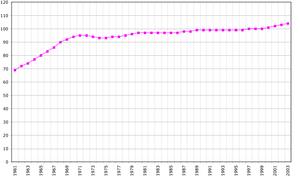- Demographics of Tonga
-
This article is about the demographic features of the population of Tonga, including population density, ethnicity, education level, health of the populace, economic status, religious affiliations and other aspects of the population.
Almost two-thirds of the population of the Kingdom of Tonga live on its main island, Tongatapu. Although an increasing number of Tongans have moved into the only urban and commercial center, Nukuʻalofa, where European and indigenous cultural and living patterns have blended, village life and kinship ties continue to be important throughout the country. Everyday life is heavily influenced by Polynesian traditions and especially by the Christian faith; for example, all commerce and entertainment activities cease from midnight Saturday until midnight Sunday, and the constitution declares the Sabbath to be sacred, forever. Tonga is said to have the highest proportion of Mormons of any state or country outside of Utah. Other important Christian denominations include Methodists (Free Wesleyan) and Roman Catholics.
Tongans, a Polynesian group with a very small mixture of Melanesian, represent more than 98% of the inhabitants. The rest are European (the majority are British), mixed European, and other Pacific Islanders. There also are several hundred Chinese.
Primary education between ages 6 and 14 is compulsory and free in state schools. Mission schools provide about 83% of the primary and 90% of the secondary level education. Higher education includes teacher training, nursing and medical training, a small private university, a women's business college, and a number of private agricultural schools. Most higher education is pursued overseas.
CIA World Factbook demographic statistics
The following demographic statistics are from the CIA World Factbook, unless otherwise indicated. popution of tonga in 2010 110,000
Age structure
- 0-14 years: 36.2% (male 20,738/female 19,907)
- 15-64 years: 59.7% (male 33,226/female 33,853)
- 65 years and over: 4.2% (male 2,031/female 2,667) (2005 est.)
Population growth rate
- 4.95% (2006 est.)
Birth rate
- 999 births/1,000 population (2005 est.)
Death rate
- 999 deaths/1,000 population (2005 est.)
Net migration rate
- 0 migrant(s)/1,000 population (2005 est.)
Sex ratio
- At birth:56.05 male(s)/female
- Under 15 years: 52.04 male(s)/female
- 15-64 years: 0.98 male(s)/female
- 65 years and over: 0.76 male(s)/female
Total population
- 0.99 male(s)/female (2005 est.)
Infant mortality rate
- 14.45 deaths/1,000 live births (2005 est.)
Life expectancy at birth
- Total population: 69.53 years
- Male: 67.05 years
- Female: 72.14 years (2005 est.)
Total fertility rate
- 3 children born/woman (2005 est.)
Health
70 per cent of Tongan women aged 15–85 are obese. Tonga and nearby Nauru have the world’s fattest populations.[1]
Nationality
- Noun: Tongan(s)
- Adjective: Tongan
Ethnic groups
- Polynesian, Europeans about 300
Religions
Everyone in Tonga is Christian[citation needed], of the Christians, they belong to these churches: Free Wesleyans (38,052 or 37%); Mormons (17,109 or 17%); Catholics (15,992 or 16%); Free Church of Tonga (11,599 or 11%) (Census 2006)
Languages
Languages of Tonga Official language(s) Tongan
EnglishSignificant unofficial language(s) Niuafo'ou Common keyboard layout(s) Tongan QWERTY The indigenous languages of the Kingdom of Tonga are the two Austronesian languages of Tongan and Niuafo'ou. Along with Tongan, English is also an official language.
Literacy
- Definition: Can read and write Tongan and/or English
- Total population: 98.5%
- Male: 98.4%
- Female: 98.7% (1996 est.)
Demographics of Oceania Sovereign states Dependencies and
other territories- American Samoa
- Christmas Island
- Cocos (Keeling) Islands
- Cook Islands
- Easter Island
- French Polynesia
- Guam
- Hawaii
- New Caledonia
- Niue
- Norfolk Island
- Northern Mariana Islands
- Pitcairn Islands
- Tokelau
- Wallis and Futuna
References
Languages of Oceania Sovereign states - Australia
- East Timor (Timor-Leste)
- Fiji
- Indonesia
- Kiribati
- Marshall Islands
- Federated States of Micronesia
- Nauru
- New Zealand
- Palau
- Papua New Guinea
- Samoa
- Solomon Islands
- Tonga
- Tuvalu
- Vanuatu
Dependencies and
other territories- American Samoa
- Christmas Island
- Cocos (Keeling) Islands
- Cook Islands
- Easter Island
- French Polynesia
- Guam
- Hawaii
- New Caledonia
- Niue
- Norfolk Island
- Northern Mariana Islands
- Pitcairn Islands
- Tokelau
- Wallis and Futuna
Categories:- Demographics by country
- Tongan society
Wikimedia Foundation. 2010.

